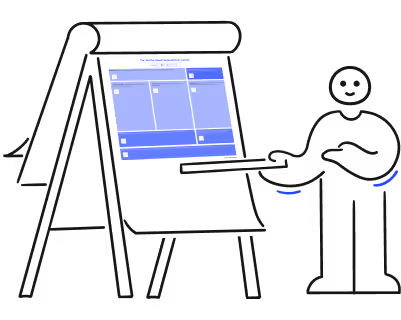Formal vs Informal Learning: How Best to Develop Your Employees

Empower your organization with the skills-based canvas.

Does your business offer a formal learning program or do you rely on informal learning?
It's a fact: corporate training allows employees to perform better. Some studies even show that employees in the labor market who benefit from continuous training are 3 % to 5 % more performant than employees who have an equal experience level but do not receive training.
My own career path has allowed me to distinguish several learning types: there are businesses who provide formal education, in person or online, synchronous or asynchronous, and others, who expect their employees to take charge of their professional development on their own.
So, which is best? Should employees be offered formal or informal training?
Formal learning pays off
It is easy to say that a formal learning environment is expensive because it does require a certain investment. At the same time, your teams may include highly performing employees who don't seem to need any training, judging by their results.
But without a formal training program, you should ask yourself a few simple questions:
- Is everyone really performing at their best?
- Are the tools that I invest in, such as a knowledge management system or an HRIS (Human Resources Information System), being used to their full potential?
- Do all my employees have the knowledge they need to reach their goals?
This is where formal training comes in:
It optimizes the tools being used and updates the entire organization's existing knowledge level.
Let's take a closer look at each of these terms.
Two learning styles - Informal vs Formal learning
Before going further, we need to clearly understand the differences between formal and informal learning. Beyond being aware of the time and costs involved, it helps to have a clear idea of the path ahead.
Formal learning - definition
Formal learning programs are defined by its very structure. It involves an organized learning process in a formal setting that allows the transfer of predefined knowledge, with a specific goal.
It is the type of learning that would yield quantifiable results and address a specific need of your team or organization.
What I have always liked about formal training is that it gave me a clearer picture of the direction I needed in my work.
A good example of formal learning would be a corporate training program on customer care standards or sales procedures. By creating this type of content and making it available online, you can help even out your team's knowledge.
A knowledge gap analysis is a great tool for identifying the next formal training your employees would benefit from.
Informal learning - definition
As indicated by the name, non-formal and informal learning approaches occur organically and without much structure; it ranges from chatting with colleagues around the coffee machine to listening to a podcast on the bus, to the experiential learning one accrues while performing a task. Whatever the setting, one can develop skills and learn in a freer environment.
Non-formal learning encompasses all the small actions that lead to developing one's knowledge of a given subject.
Oftentimes, it is something employees will take on, on their own, but you can surely encourage it!
Main features of formal and informal learning
How to choose the format that suits your organization's needs
Informal Learning - Organic and Spontaneous
While it is more useful to focus your development efforts on formal training, informal learning situations bring several clear advantages. Informal settings do not require a manager's involvement, they allow teams to bring in new ideas without feeling pressured, and they can even help change perspectives and outlooks.
If you encourage informal education and social learning, it can even yield better communication and cohesion within your teams.
One of my former managers used to organize a monthly voluntary content club, where we would discuss readings, podcasts and shows that we had found useful in one aspect of our work or another. These meetings encouraged sharing and also allowed us to get to know our colleagues better, a perfect example of non-formal training.
However, there is a downside to informal learning environments: because we are biased in our choices, we tend to choose content related to subjects we already know.
Using formal learning to delve deeper
We don't know what we don't know.
This is a simple phrase a more experienced colleague once told me during a training session. Formal programs aim to address this gap with more intentional learning and more structured development opportunities.
Formal training programs offer your employees the knowledge they need in their work, thus allowing you to reach the goals you set together.
In fact, a formal education program must be as clear as your goals. It is similar to a training regimen that allows athletes to compete in the Olympics.
How to create an online formal learning on an LMS?
Where should you start? It can be daunting to look up at the mountain peak from base camp, but you never start climbing without prior preparation, and the same applies to employee training.
It is important to clearly understand the starting point and be aware of the employees' knowledge level and gaps so that you may identify their needs to help them reach their goals.
Once you have done the knowledge analysis, a few simple steps will allow you to create a program that is tailored to your organization's needs:
- Define the project
- Identify your audience and your strategies
- Set training goals and define the program structure
- Set the program title and description
- Create clear summaries for each of the program sections
- Establish the evaluation criteria
The good news is that once you have created your content and integrated it onto an LMS, your work is done! Except for a few updates, occasionally, your online training will be available to your employees, and they will be able to watch it time and time again.
That's the beauty of formal learning experiences: they are a lot easier to standardize and own, which increases their return on investment.
Train your team and aim for the top with formal and informal learning
All organizations have goals they aim to reach. Some are milestones and others are ultimate goals.
Remember: athletes start at local levels before they get to world championships!
If you aim for the podium, one thing is certain: each step on the way is crucial. Each type of training has its value, whether it is daily physical training that keeps your body fit - formal training, or a soundtrack that helps your mind gain focus - informal training.
The big difference is that you are responsible for the formal training, and you can create training programs that help everyone involved achieve their goals. That is what you should be focusing your efforts on, to make sure everyone starts off at the same place.
%20(1).png)

%20(1).avif)


.avif)
.avif)








